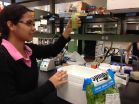Spotlighting the sun
Partial solar eclipse shows off massive sunspot
2014-10-27
(Press-News.org) Astronomers with the National Science Foundation (NSF)-funded National Optical Astronomy Observatory (NOAO) captured pictures not only of Thursday's partial solar eclipse, but also of the "monster" sized active region or sun spot that has many comparing it to one of a similar size that occurred 11 years ago.
The sun spots were earlier reported by scientists with the NSF-supported National Solar Observatory. According to astronomers Frank Hill and Kiran Jain, "As of Oct 21, 2014, a very large active region is currently on the solar disk and producing flares as strong as an X1. [Solar flares are classified according to their strength, and X-class flares are the biggest.] It is eerily reminiscent of another very large active region, which appeared almost exactly 11 years ago around Halloween 2003 very close to the same location on the sun and produced an X17 event, the largest solar flare recorded in modern history. That flare was one of a series of very strong flares now known as the Halloween flares. We may be in for an encore. This active region currently covers 2,000 millionths of the solar disk area and is almost the size of Jupiter."
What's the significance of active regions?
When they produce X17 events with solar winds that spew solar matter full of charged particles, they can impact the Earth's ionosphere, the very upper part of our atmosphere. That's where our satellites reside, so extreme solar winds can hamper our communications systems that rely on these satellites, such as GPSs and telecommunications, as well as have impact on power grids. Additionally, the increased solar activity makes that upper atmosphere a little hotter, which causes more wear-and-tear on the satellites. The last Halloween flares actually knocked out power grids in Sweden, so they can be cause for concern here on Earth. The current active region showed up in late September and is likely to stick around for a few weeks, so astronomers are monitoring it closely to see how it grows or changes.
And NOAO's Robert Sparks showed that sometimes all it takes is a phone camera and a telescope to provide photos with amazing detail. In two of the photos, he used cell phones attached to a telescope, providing not only a good look at the sun's active region, but also prominences (large, bright, gaseous features that extend outward from the sun's surface, often in loop shapes) and filaments (large regions of very dense, cool gas, held in place by magnetic fields that appear as dark, long and thin).
INFORMATION:
ELSE PRESS RELEASES FROM THIS DATE:
2014-10-27
A large active region on the sun erupted with another X-class flare on Oct. 27, 2014 -- its fourth since Oct. 24. The flare peaked at 10:47 a.m. EDT.
X-class denotes the most intense flares, while the number provides more information about its strength. An X2 is twice as intense as an X1, an X3 is three times as intense, etc.
To see how this event may affect Earth, please visit NOAA's Space Weather Prediction Center at http://spaceweather.gov, the U.S. government's official source for space weather forecasts, alerts, watches and warnings.
Continuing a week's worth ...
2014-10-27
A world without plants would be a world without oxygen, uninhabitable for us and for many creatures. We know plants release oxygen by absorbing carbon dioxide and breaking down water using sunlight through the process of photosynthesis. However, we know little about the mechanics of how plants create oxygen during photosynthesis. A breakthrough that will help advance our understanding of this critical ecological process was made recently by scientists at LSU.
"Without photosynthesis or oxygen, basically all recognizable life that we see in our landscape would be gone: ...
2014-10-27
Chicago, October 27, 2014—The Associated Press-NORC Center for Public Affairs Research today released the results of a major new study and related reports on the recovery from Superstorm Sandy in 12 New York and New Jersey neighborhoods hard hit by the 2012 storm.
It is the second AP-NORC study that has focused on the aftermath of Superstorm Sandy, with findings that emphasize the important role social factors play in a neighborhood's resilience: the ability of people and their social systems to survive, adapt and continue moving forward after a disaster. Funding ...
2014-10-27
This news release is available in French. One in three children who have been reunified with their families after being placed in foster care will be maltreated again, according to a study into Quebec's youth protection system by Marie-Andrée Poirier and Sonia Hélie of the University of Montreal's School of Social Services. The study, the first of its kind in the world, was undertaken in the wake of a new law intended to improve the family stability of youth receiving child protection services.
The researchers, who are also affiliated with the Centre jeunesse ...
2014-10-27
Due to its unprecedented scope, the damage assessment caused by the 2010 Deepwater Horizon spill in the Gulf of Mexico has been a challenge. One unsolved puzzle is the location of 2 million barrels of submerged oil thought to be trapped in the deep ocean.
UC Santa Barbara's David Valentine and colleagues from the Woods Hole Oceanographic Institute (WHOI) and UC Irvine have been able to describe the path the oil followed to create a footprint on the deep ocean floor. The findings appear today in the Proceedings of the National Academy of Sciences.
For this study, the ...
2014-10-27
Humans are the only primates with large, highly visible sclera – the white part of the eye.
The eye plays a significant role in the expressiveness of a face, and how much sclera is shown can indicate the emotions or behavioral attitudes of a person. Wide-open eyes, exposing a lot of white, indicate fear or surprise. A thinner slit of exposed eye, such as when smiling, expresses happiness or joy. Averted eyes, as well as direct eye contact, can mean several things. So the eye white, or how much of it is shown and at what angle, plays a role in the social and cooperative ...
2014-10-27
It's an often-agonizing challenge facing any parent of a child with autism: How can I help my son or daughter socialize with his or her typically developing peers? The solution, SF State's Pamela Wolfberg found, may lie in a different type of playgroup that focuses on collaborative rather than adult-directed activities.
A new study shows that "Integrated Play Groups," or IPGs, developed by Wolfberg over several years, are effective in teaching children with autism the skills they need to interact with their peers and engage in symbolic play such as pretending. In IPGs, ...
2014-10-27
Where's the remaining oil from the 2010 Deepwater Horizon disaster in the Gulf of Mexico?
The location of 2 million barrels of oil thought to be trapped in the deep ocean has remained a mystery. Until now.
Scientist David Valentine of the University of California, Santa Barbara (UCSB) and colleagues from the Woods Hole Oceanographic Institution (WHOI) and the University of California, Irvine, have discovered the path the oil followed to its resting place on the Gulf of Mexico sea floor.
The findings appear today in the journal Proceedings of the National Academy ...
2014-10-27
The first images of a nova during its early fireball stage--when it ejects material, and gases expand and cool--show that this activity is more complicated than predicted.
That is the conclusion, published in the current issue of Nature, from a research collaboration led by Georgia State University Astronomer Gail Schaefer that includes 37 researchers (many who are National Science Foundation (NSF)-funded) from 17 institutions. The researchers observed the expanding thermonuclear fireball from a nova that erupted last year in the constellation Delphinus.
"This is ...
2014-10-27
The uncontrolled growth of cancer cells arises from their ability to hijack the cell's normal growth program and checkpoints. Usually after therapy, a second cancer-signaling pathway will open after the primary one shuts down — creating an ingenious escape route for the cancer cell to survive. The answer, say Case Western Reserve researchers, is to anticipate and block that back-up track by prescribing two drugs from the start. The results of the project, led by Ruth Keri, PhD, Professor and Vice Chair Department of Pharmacology, and Associate Director for Basic Research ...
LAST 30 PRESS RELEASES:
[Press-News.org] Spotlighting the sun
Partial solar eclipse shows off massive sunspot







